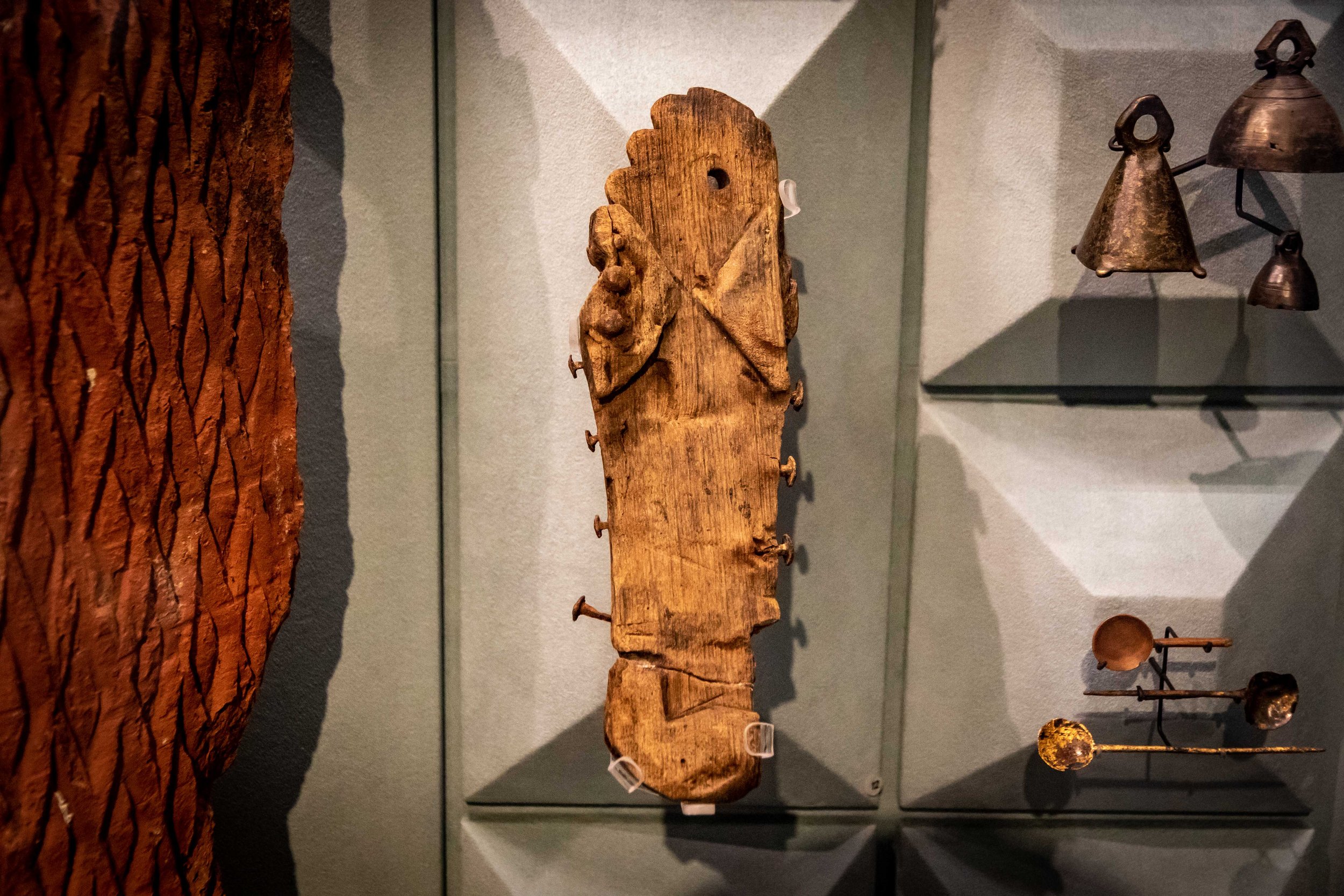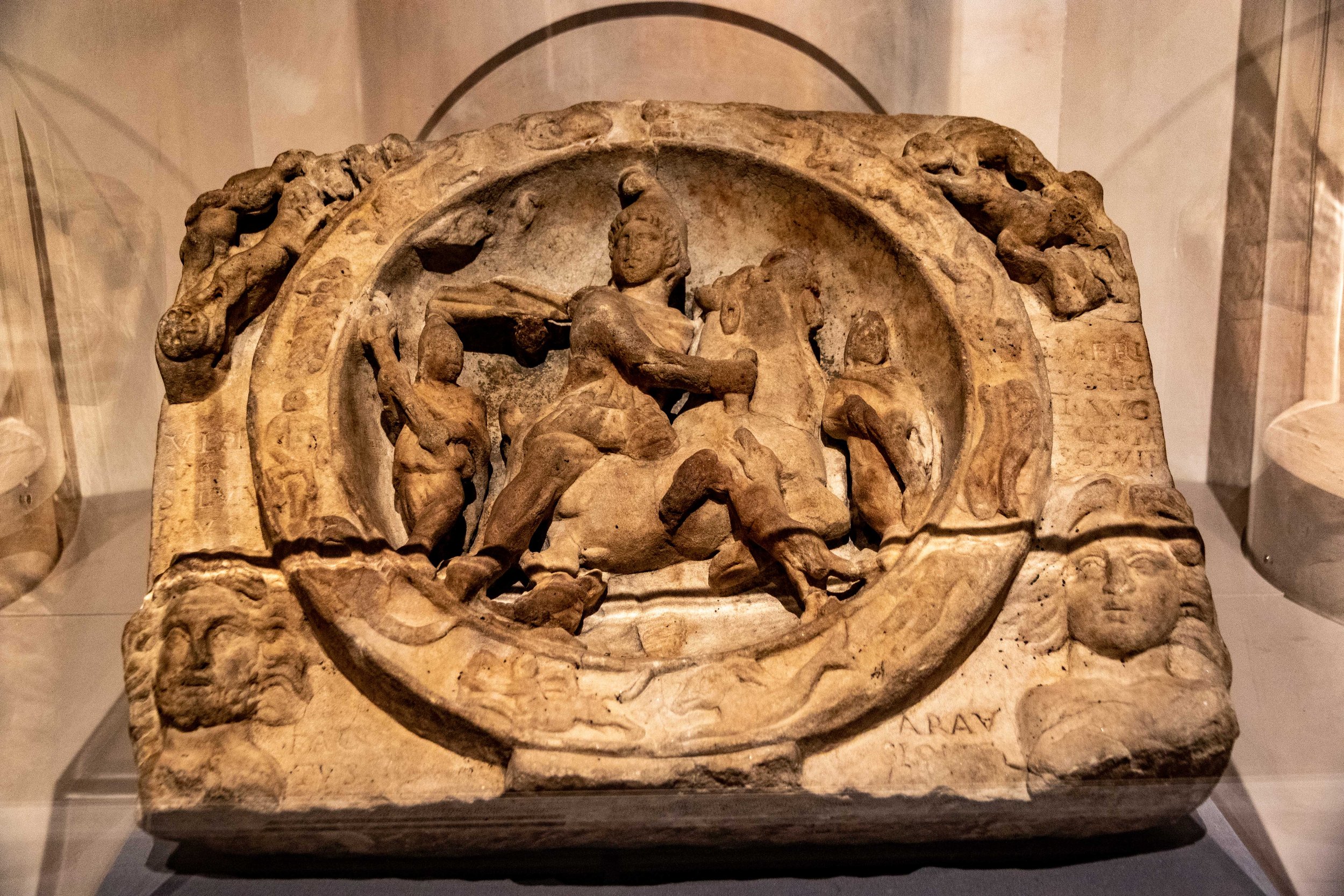The London Mithraeum, discovered in 1954 under the bombed out ruins of London and now rebuilt to give you a “memorable, powerful and authentic experience.” — Seeing the past
The lower section of a wooden Roman door; an incredibly rare survival from the early phases of Roman Londinium, around 50-100 AD, preserved under the City in the wet soil of the lost Walbrook river. London Mithraeum
Your first view of the London Mithraeum. The London Mithraeum was built 1800 years ago by the Romans and dedicated to the god, Mithras and reopened in December 2018. In 1952 a small section of a Roman building was discovered and on the last day of the dig in 1954 its function was confirmed as a temple devoted to the God Mithras. The evidence on that last day was a sculpted head of Mythras. There was a huge amount of interest in the press and thousands queued for hours to take a look at the remains. All the remains were then put in storage until the new office block was completed. In 1962, the reconstructed temple was opened to the public and they, once again, flocked in to see it. Unfortunately, the reconstruction was built 100 yards from the original site and there were several other things wrong with it. It had been re-orientated to be north-south whereas it should have been east-west. It was originally constructed partly below ground and was dark and windowless but was now all above ground. The original design was to symbolise that Mithras killed a bull within a cave and so had to be fairly dark unlike the reconstruction. Added to this, the floor paving was wrong, several other architectural features had been ignored and the cement mortar was modern.

ABOVE. THE SCULPTURE OF MITHRAS, FOUND ON THE LAST DAY OF THE ORIGINAL DIG. IT IS NOW TO BE FOUND IN THE MUSEUM OF LONDON.
The story now moves forward to 2010 when Bloombergs, the financial information company, bought the site to build its new European headquarters. One of the clauses in the granting of planning permission was that the temple site be “re-imagined” as well as protected. One of the aims of the new reconstruction was that it should evoke the experience of being in a mithraeum as well as being in its original position with east-west orientation. The actual design brief stated “to create a memorable, powerful and authentic experience.” The excavation that took place between 2012-2014 discovered more than 14 000 artefacts, together with 63 000 pieces of pottery and 3 tonnes of animal bones. This together with the original finds means that this was has become a highly important site in the history of London. Over 400 pieces of writing tablets have been found and this includes the first known reference to London and the earliest hand written document.
The temple was first built around 240-250AD and was eventually abandoned in about 380AD. Mithraic initiates were required to swear an oath of secrecy and dedication. Followers could rise through 7 different grades or ranks and this was symbolised by 7 columns down each side of the building, a feature borne out by the careful lighting today. Some experts state that the birthday of Mithras was celebrated on December 25th but other experts refute this, stating this was a general festival of the Sun and there were no specific public ceremonies. Unfortunately, their oath of secrecy meant that we have little actual evidence about their rituals and beliefs.Other gods were often represented in Mithraeums and Mithraism was not seen as an alternative to the Roman Empire’s traditional religions.
We would recommend a visit to the Museum of London, which is within walking distance, to see some of the sculptures retrieved from the archaeological dig.


Above a case of 600 finds from the excavations.

Above and below. On entering the building, the first thing you see, after checking in, is a large display of Roman artefacts that were discovered when they excavated the Mithraeum. In the display cabinet, there was a surprising number of shoes and sandals, artefacts that one would think, would have completely decayed after nearly 2000 years but the wet conditions and lack of oxygen prevented bacteria from destroying them.


In the display cabinet, there is a bull badge. It is believed that this probably represents the astrological sign Taurus, dated pre-Mithraeum. However, the bull is a key figure in Mithraeums and in many Roman religions.

Above. The display cabinet also has a beautiful piece of Samianware. It shows gladiators fighting or at least practising.

Above. A beautiful pot in excellent condition, probably for storing food.

Above, a re-usable writing tablet. Molten wax was poured into each tray and left to harden. A stylus that looks like a large pin then scratches out words and sentences in the wax. When the information is redundant, the wax is melted and the process happens all over again.

Above. Spearheads.

Above. Mithras killing a bull. Now found in the Museum of London, a few hundreds yards from the Bloomberg building.
Below. Neptune or another god associated with water. Both of these cultures were found buried beneath the floor of the temple. Now found in the Museum of London, a few hundreds yards from the Bloomberg building.
Related Post
A shocking documentary proves that mermaids do exist
SHOCKING Revelation: Thuya, Mother of Queen Tiye, Was the Grandmother of Akhenaten and Tutankhamun—What Ancient Egyptian Secrets Did She Leave Behind?
Breaking News: Astonishing Discoveries at Karahan Tepe Confirm an Extraterrestrial Civilization is Hiding on Earth, and NO ONE Knows!
Breaking News: Researchers FINALLY Discover U.S. Navy Flight 19 After 75 Years Lost in the Bermuda Triangle!
NASA’s Secret Investigation: Uncovering the Astonishing Mystery of the UFO Crash on the Mountain!
Explosive UFO Docs LEAKED: Startling Proof That Aliens Ruled Ancient Egypt!